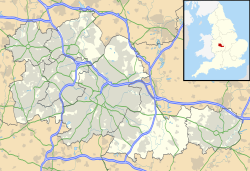Dudley Castle
| Dudley Castle | |
|---|---|
| Part of Dudley Zoological Gardens | |
| Dudley, West Midlands | |

The keep of Dudley Castle
|
|
| Coordinates | 52°30′51″N 2°04′48″W / 52.5142°N 2.0800°W |
| Type | Motte and Bailey |
| Site information | |
| Owner | Dudley Metropolitan Borough Council |
| Controlled by | Dudley and West Midlands Zoological Society |
| Open to the public |
Yes |
| Condition | Ruined |
| Site history | |
| Built | 1070 |
| Built by | Ansculf de Picquigny |
| In use | Until 1750 |
| Materials | Limestone |
| Battles/wars |
The Anarchy English Civil War |
Dudley Castle is a ruined fortification in the town of Dudley, West Midlands, England. Originally a wooden motte and bailey castle built soon after the Norman Conquest, it was rebuilt as a stone fortification during the twelfth century but subsequently demolished on the orders of King Henry II. Rebuilding of the castle took place from the second half of the thirteenth century and culminated in the construction of a range of buildings within the fortifications by John Dudley. The fortifications were sleighted by order of Parliament during the English Civil War and the residential buildings destroyed by fire in 1750. In the nineteenth and early twentieth century the site was used for fêtes and pageants. Today Dudley Zoo is located in its grounds.
The location, Castle Hill, is an outcrop of Wenlock Group limestone that was extensively quarried during the Industrial Revolution, and which now along with Wren's Nest Hill is a Scheduled Ancient Monument as the best surviving remains of the limestone industry in Dudley. It is also a Grade I listed building. The Dudley Tunnel runs beneath Castle Hill, but not the castle itself.
According to legend, a wooden castle was constructed on the site in the 8th century by a Saxon lord called Dud. However this legend is not taken seriously by historians, who usually date the castle from soon after the Norman Conquest of 1066. It is thought one of the Conqueror's followers, Ansculf de Picquigny, built the first castle in 1070. and that his son, William Fitz-Ansculf, was in possession of the castle when it was recorded at the time of the Domesday Book of 1086. Some of the earthworks from this castle, notably the "motte", the vast mound on which the present castle keep now sits, still remain. However the earliest castle would have been of wooden construction and no longer exists.
...
Wikipedia

